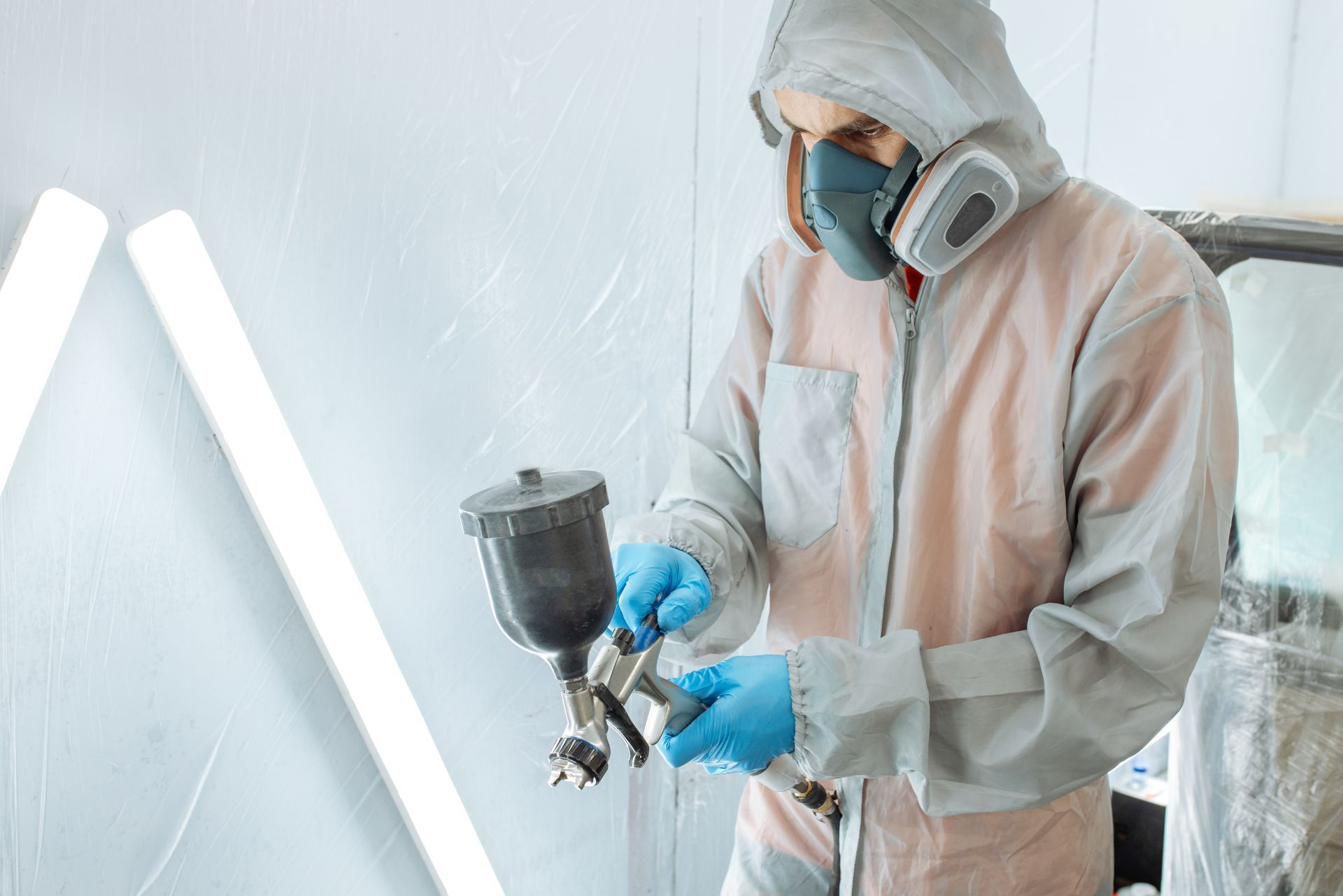Top 3 Recommended Policies

Painting contractors in New York face a unique set of risks every day. From accidental property damage to workplace injuries, the challenges are real and costly. With an average annual salary of $66,077, these professionals not only invest their skills but also their livelihoods into their craft. Protecting that investment means understanding how insurance can safeguard their business and peace of mind. This article dives into the essential insurance types painting contractors need and how these policies work specifically in New York.
Why Painting Contractors Need Specialized Insurance
Painting is more than just applying color to walls. It involves working at heights, handling potentially hazardous materials, and navigating client properties that vary widely. A single slip or spill can lead to expensive claims. Without insurance, the financial fallout could threaten a contractor’s business survival.
New York’s dense urban environment adds complexity. Tight spaces, busy job sites, and strict local regulations increase the chances of accidents or property damage. Insurance tailored to these risks helps contractors manage potential liabilities and comply with state laws.
For example, workers’ compensation insurance is mandatory for most painting businesses with employees in New York. This coverage protects workers injured on the job and shields the contractor from costly lawsuits. According to ContractorNerd, painting contractors in New York typically pay $13.20 per $100 of payroll for this coverage. This rate reflects the physical demands and injury risks inherent in painting work.
In addition to workers' compensation, general liability insurance is crucial for painting contractors. This type of insurance covers claims related to property damage or bodily injury that may occur during a project. For instance, if a contractor accidentally spills paint on a client's expensive carpet or damages a piece of furniture while moving it, general liability insurance can help cover the costs of repairs or replacements. This protection not only safeguards the contractor's finances but also enhances their reputation, as clients are more likely to trust a contractor who is adequately insured.
Moreover, specialized insurance can also include coverage for equipment and tools, which are essential for any painting job. Paint sprayers, ladders, and scaffolding can be costly investments, and if they are damaged or stolen, it can significantly disrupt a contractor's workflow. Having equipment insurance ensures that these tools can be replaced quickly, minimizing downtime and allowing the contractor to maintain their schedule and client commitments. In a competitive market like New York, where time is often of the essence, this type of coverage can be a game-changer for a painting business.

Understanding the Cost of Painting Business Insurance in New York
Insurance costs vary based on coverage types, business size, and risk factors. Painting contractors in New York can expect annual insurance premiums ranging from $1,456 to $2,940. This range depends on the specific policies chosen, such as general liability, workers’ compensation, and commercial auto insurance.
General liability insurance is crucial. It covers third-party claims for bodily injury or property damage caused by the contractor’s operations. For painters, this could mean covering damage to a client’s property or injuries sustained by visitors at a job site. Additionally, having this coverage can enhance a contractor's credibility, as clients often prefer to work with insured professionals, knowing they are protected against potential mishaps.
MoneyGeek reports that these insurance costs can fluctuate depending on coverage limits and deductibles. Contractors who invest in comprehensive policies may pay more upfront but avoid devastating out-of-pocket expenses later. For many, this balance is essential to maintaining a stable business. Moreover, understanding the nuances of each policy can empower contractors to make informed decisions that align with their business goals and risk tolerance.
Painting contractors should also consider the indirect costs of insurance. For example, higher payroll means higher workers’ compensation premiums. Since the average salary in New York is over $66,000, the payroll-based nature of workers’ compensation premiums means this coverage can be a significant budget item. Furthermore, contractors may want to explore safety training programs for their employees, as implementing such measures can lead to lower premiums over time by reducing the likelihood of claims.
Another important aspect to consider is the impact of seasonal work on insurance costs. Many painting contractors experience fluctuations in their workload throughout the year, which can affect their insurance needs. During peak seasons, when demand for painting services surges, contractors may need to adjust their coverage or even consider temporary policies to accommodate the increased risk associated with higher activity levels. This strategic approach can help manage costs effectively while ensuring adequate protection.
More details on these expenses can be found at MoneyGeek’s painting business insurance cost guide.
Key Insurance Policies for Painting Contractors
General Liability Insurance
This is the foundation of any painting contractor’s insurance portfolio. It protects against claims of property damage or bodily injury caused by the contractor’s work. For example, if paint accidentally spills on a client’s expensive flooring, general liability insurance covers the repair or replacement costs.
Without this coverage, contractors risk paying large claims out of pocket, which can quickly drain resources and harm their reputation. Additionally, general liability insurance can also cover legal fees if a claim leads to a lawsuit, providing a safety net that allows contractors to focus on their work rather than worrying about potential financial ruin. It’s crucial for contractors to understand the specific terms of their policy, including any exclusions or limits, to ensure they have adequate protection for their unique business needs.
Workers’ Compensation Insurance
In New York, workers’ compensation insurance is not optional for most painting businesses with employees. It covers medical expenses and lost wages if a worker gets injured on the job. Given the physical nature of painting—climbing ladders, handling chemicals, and working in awkward positions—injuries are a real possibility.
The cost is tied to payroll, with painting contractors paying about $13.20 per $100 of payroll, according to ContractorNerd. This means that as your business grows and you hire more painters, expect your workers’ comp premiums to increase accordingly. Moreover, maintaining a safe work environment can help mitigate these costs. Implementing safety training and protocols not only protects employees but can also lead to lower insurance premiums over time, creating a win-win situation for both the contractor and their workforce.
Commercial Auto Insurance
Many painting contractors use vehicles to transport equipment and materials. Commercial auto insurance covers accidents involving these vehicles, protecting both the contractor and clients. Personal auto insurance typically excludes business use, making this coverage essential. This type of insurance not only covers damages to the vehicle but also liability for injuries or damages caused to others in an accident.
Furthermore, commercial auto insurance can also provide coverage for equipment that is being transported in the vehicle, which is particularly important for painting contractors who often carry expensive tools and supplies. In the event of an accident, having this coverage can significantly reduce the financial burden of replacing or repairing damaged equipment, ensuring that contractors can quickly get back to work without major interruptions.
Tools and Equipment Insurance
Painting requires specialized tools and equipment that can be expensive to repair or replace. This insurance covers theft, loss, or damage to these assets, reducing downtime and financial strain. Many contractors invest heavily in high-quality brushes, sprayers, ladders, and scaffolding, and losing these tools can severely impact their ability to complete jobs on time.
Additionally, tools and equipment insurance can also cover rental costs if a contractor needs to temporarily replace lost or damaged tools while waiting for repairs or replacements. This coverage is particularly beneficial in the fast-paced world of contracting, where time is money, and delays can lead to dissatisfied clients and lost business opportunities.
Professional Liability Insurance
Though less common for painters, professional liability insurance can protect against claims of negligence or poor workmanship. This coverage is especially useful for contractors who provide consulting or design advice alongside painting services. In an industry where client expectations can be high, having this insurance can provide peace of mind, knowing that you are protected against potential claims that could arise from dissatisfied customers.
Moreover, as the painting industry evolves, more contractors are expanding their services to include project management and design elements. This shift increases the importance of professional liability insurance, as it can cover claims related to miscommunication or failure to deliver on client expectations. By investing in this type of coverage, painting contractors can enhance their credibility and attract more clients who seek assurance that their projects are in capable hands.
How Insurance Supports Business Growth and Compliance
Insurance is more than a safety net; it’s a business enabler. Clients often require proof of insurance before awarding contracts. Having the right coverage can open doors to larger projects and commercial contracts. This is particularly true in competitive industries where clients are looking for reassurance that their contractors are not only qualified but also adequately protected against potential mishaps. For instance, a painting contractor with comprehensive liability insurance is more likely to win contracts with larger firms that prioritize risk management.
Moreover, compliance with New York’s insurance regulations avoids costly fines and legal troubles. Workers’ compensation is legally required for most employers, and failing to carry it can result in penalties and lawsuits. This compliance not only protects the business from legal repercussions but also fosters a culture of safety and responsibility among employees. When workers feel secure, their productivity often increases, contributing positively to the overall work environment and enhancing the company’s reputation in the industry.
Insurance also helps contractors manage cash flow by shifting unpredictable risks to insurers. Instead of setting aside large emergency funds, contractors can invest in marketing, tools, or hiring, knowing they have protection against major setbacks. This financial flexibility allows businesses to pursue growth opportunities that they might otherwise forgo due to the fear of unforeseen expenses. For example, a contractor can confidently take on a new project that requires upfront investment, secure in the knowledge that their insurance will cover any potential liabilities that arise during the job.
For painting contractors aiming to expand, insurance is a critical part of a sustainable growth strategy. It not only provides a safety net but also enhances credibility with potential clients. Additionally, having a robust insurance policy can serve as a marketing tool in itself; contractors can advertise their coverage as a testament to their professionalism and commitment to quality work. Furthermore, as the business grows, the complexity of projects often increases, making it essential to have the right insurance policies in place to cover new risks associated with larger jobs, specialized equipment, or a growing workforce.

| Insurance Type | Typical Annual Cost in NY | What It Covers | Why It Matters |
|---|---|---|---|
| General Liability | $1,000 - $2,000 | Third-party injury and property damage | Protects against costly client claims |
| Workers’ Compensation | Payroll-based ($13.20 per $100 payroll) | Employee injury medical and wage benefits | bill.Required by law, protects employees and businessfernandez@mail.com |
| Commercial Auto | $500 - $1,500 | Vehicle accidents and damages | Essential for business vehicle use |
| Tools and Equipment | $300 - $700 | Theft, loss, or damage of tools | Minimizes downtime and replacement costs |
| Professional Liability | $500 - $1,000 | Claims of negligence or errors | Protects reputation and legal costs |
This table summarizes typical costs and coverage areas for painting contractors in New York. Actual premiums vary based on business size, claims history, and coverage limits.
Protecting Your Investment: What Painting Contractors Should Remember
Insurance is an investment in stability. Painting contractors often focus on tools and skills but underestimate how quickly a single claim can derail their business. With an average salary of $66,077 in New York, protecting income and assets is critical.
Choosing the right insurance means balancing cost with coverage. Cheaper policies may leave gaps, while comprehensive plans provide peace of mind. Talking to an insurance professional familiar with painting businesses can help tailor coverage to specific risks and budgets.
Regularly reviewing policies is also important. As your business grows or changes, insurance needs evolve. Staying proactive ensures continuous protection without surprises.
For more insights on painting business insurance costs and options, visit MoneyGeek’s detailed guide.
Frequently Asked Questions
Do I need workers’ compensation insurance if I work alone?
In New York, sole proprietors without employees may not be required to carry workers’ compensation, but it’s worth considering for personal injury protection.
How does workers’ compensation premium get calculated?
It is based on your total payroll and the rate per $100 of payroll. For painters in New York, the rate is about $13.20 per $100.
Can I get insurance that covers damage to client property?
Yes. General liability insurance covers accidental damage to client property during your work.
Is commercial auto insurance necessary if I use my personal vehicle for work?
Personal auto policies usually exclude business use. Commercial auto insurance is recommended to cover work-related vehicle use.
How often should I review my insurance policies?
Review policies annually or whenever your business changes, such as hiring employees or expanding services.
Can insurance help me win bigger painting contracts?
Yes. Many clients require proof of insurance before awarding contracts, so having proper coverage can open more business opportunities.
What happens if I don’t have insurance and a claim is made?
You could face out-of-pocket costs, lawsuits, fines, and even business closure. Insurance protects against these financial risks.
Contact Us
Phone
Location
